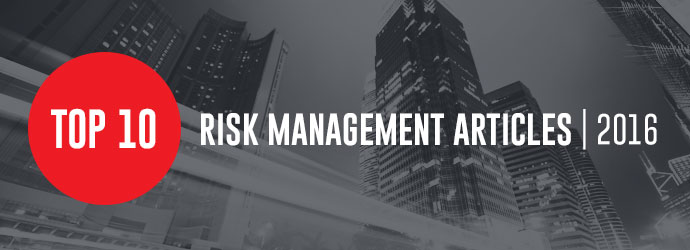Top 10 Risk Management Articles from 2016

The end of the year is a great time to reflect and with that, we like to share our most-read articles of the year. This year’s top articles highlight a strong focus on workplace violence risk management, including active assailant concerns. More than ever, prediction, preparation, and prevention measures are needed to keep each workplace safe. Take some time to read through our top risk management articles from 2016 and plan for a safer and more productive 2017.
1. [Infographic] How to Address the Threat of an Active Assailant Incident in Your Organization
Each and every employee and community member deserves to feel safe. OSHA requires it, labeling it as an organization’s responsibility to provide a safe workplace. Tragically, with a growing number of active assailant incidents happening all around the country, this threat is more relevant than ever before. Over a two-year span, 26 states experienced 40 active assailant incidents, resulting in more than 230 casualties.
2. Building a Culture of Compliance around BSA/AML – Guidance from FinCEN
In simpler times, the Bank Secrecy Act (BSA) regulated the Anti-Money Laundering (AML) activities of banks, as the name implies. In our globalized and networked world, it has expanded to cover financial institutions ranging from the biggest banks to mom and pop check cashing, or money transfer operations running out of storefronts in a mall. The Financial Crimes Enforcement Network (FinCEN) has launched actions against businesses across this spectrum for violations of BSA/AML requirements.
3. [Infographic] Workplace Violence Prevention: What You Need to Know to Build a Safer Workplace
The effects of workplace violence are wide and long lasting. Each year millions are affected, from employees to executives, impacting business from productivity to profitability. Many acts of violence are preventable, with the main responsibility resting in employers’ hands through proactive prevention. When violent acts do occur, having a plan in place can mitigate and prevent escalation.
Our latest infographic outlines the dimension of this epidemic problem, how far the impact extends, and what to do to predict, prevent, and recover from incidents. Learn how to recognize the stages of workplace violence and the components of an effective prevention program.
4. [Whitepaper] Occupational Fraud: What You Need to Know
Occupational fraud is a common problem. It is even more common than most businesses know, since many incidents are never even detected. When fraud hits, a business can be devastated by the financial costs, along with damage to morale and reputation. The costs are massive.
Our latest whitepaper, Occupational Fraud: A Hidden Killer of Organizational Performance, provides an in-depth look at the complexities of occupational fraud, so you can prevent, detect, minimize, and/or recover from it. Start with education and STOP fraud in its tracks:
5. 4 Elements of a Workplace Violence Prevention Program
The U.S. Department of Labor (DOL) reports that every year, a staggering two million people in the United States are victimized by some form of non-fatal workplace violence. DOL statistics further estimate that 1,000 homicides annually are attributed to violence in the confines of the work environment.
6. Not If But When: How to Avoid Becoming the Next Target of FinCEN AML Enforcement
If you run a business that facilitates or conducts money transactions, or transactions in other liquid commodities, you are no doubt aware of FinCEN. Rest assured that FinCEN is aware of you, too. And we predict it’s only a short matter of time before their foreshadowing of AML enforcement actions against the cash servicing and transport industry becomes a harsh reality.
7. Managing the Liability of an Active Shooter Incident
Are you prepared to manage an active shooter within your organization or a venue you manage?
Before you discount the possibility of that happening, you should know that the FBI has reported that at least 160 “active shooter incidents” occurred between 2000 and 2013, with an increasing frequency over time. These incidents combined to produce 1,043 casualties including 486 deaths. They occurred in 40 of 50 states, almost always involved a single shooter, and 70% of them were in a commercial or educational venue.
8. [Infographic] The Impact of Workplace Violence
Violence in the workplace undeniably affects the individuals who are directly attacked. But the impact also extends far beyond these direct victims to co-workers, clients, executives, shareholders and even out to the community. There are direct losses related to medical bills, workers’ comp and legal fees, as well as indirect losses reflected in diminished productivity, low morale and negative publicity – all of which can damage a company’s reputation long-term. The impact is extensive and can carry a tremendous cost.
Prevention is key.
9. Threat Assessment: Knowing Your Risks
The ultimate goal of any security program is to manage and mitigate risks. What do we mean by risk? In its broadest sense, risk can be defined as the likelihood of loss of anything having value, including people, facilities, information, equipment, and reputation. In a sense specific to security and loss prevention, risk is the probability that a particular threat will exploit a given vulnerability, leading to an unwanted result.
Knowing your risks is the obvious first step. But what is the best approach? And where do you go from there? Here are some key considerations:
10. Why Hope is Not a Risk Management Strategy
Low-probability, high-impact events are something that most individuals and organizations would rather ignore. After all, chances are it won’t happen to you. Serious workplace violence events, active shooter incidents, and other unsavory threats are on the rise but it’s easier to assume it will happen to someone else. We don’t want to think about our own mortality or that of our organizations. Instead, we hope it won’t happen to us, to our employees, to our customers, or to our communities.
But then there are these facts:
We hope you benefit from this 2016 top blogs review. Stay connected in 2017 for more helpful guidance and information from the Risk Management Blog.